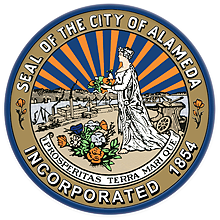Alameda Free Library Receives LEED Certification
When the Alameda Free Library was built in 2006, one of the top goals was to make it as environmentally friendly as possible. Shredded denim jeans were used as insulation in walls, natural light was used throughout the library, and infrastructure was installed for solar panels that could not be afforded at the time. Those solar panels eventually arrived in 2011, thanks to a grant from Alameda Municipal Power (AMP)—and other green innovations have been added over the years.
All of that work has paid off. In August, the library received a LEED v. 4 Existing Building Gold Certification from the U.S. Green Building Council (USGBC). In presenting the new LEED plaque to the City, Kevin Hydes of the USGBC congratulated the City Council for going the extra mile and being leaders in this area. Mr. Hydes stated, "It is the first in the country, for a Library, to receive LEED v.4 Existing Building Gold Certification.”
LEED, or Leadership in Energy & Environmental Design, is a green building certification program that recognizes best-in-class strategies and practices. To receive LEED certification, building projects satisfy prerequisites and earn points to achieve different levels of certification.
“From the beginning of construction, the library strived to be an environmentally responsible community gathering place,” says Library Director Jane Chisaki. “After nearly ten years, it is rewarding to have achieved LEED Gold for Existing Building for what is already such a cherished asset in the community.”
Before this recent Existing Building certification under the operations and maintenance category, the library received a LEED Silver certification as a new building, again highlighting its environmental friendly use of resources.
“The push for Gold certification began about a year ago,” says Chisaki, “as a way to show that the existing building was being maintained and improved upon.”
“One of the main improvements made in the past year was installing hand dryers in the library’s restrooms,” Chisaki says. The change to hand dryers reduced the library’s waste output and is saving more than $800 per month in expensive recycled paper towels.
Here are some other ways the library uses resources efficiently:
- Solar power. The solar panels on the roof have saved the library 18-20% in electricity costs.
- Floors. The carpets are made of recycled plastic bottles, and walk-off mats are made of recycled tires.
- Lighting. Dynamic lighting is used throughout the library to use sunlight whenever possible. To reduce light pollution, a lighting control system adjusts lighting levels after-hours.
- Water. Water conserving indoor plumbing fixtures and fittings exceed plumbing codes. Fixtures carry the WaterSense label from the Environmental Protection Agency (EPA), certifying that they’re at least 20% more efficient without sacrificing performance. The library also has in-line components to receive recycled water when it becomes available for landscaping.
- Insulation. In the children’s area of the library is a window in the wall to see the shredded blue denim jeans used to insulate the building instead of traditional insulation.
- Waste Materials. To minimize landfill waste, separate containers are available for employees and patrons to use for disposal, recyclables, and composting.
- Alternative transportation. A transportation survey was done of library users, finding that most walk, bike, or take a bus to the library.
- Purchasing products. All cleaning products, including soap and janitorial cleaning products, are green. In addition, electric-powered equipment is either green or will be brought up to green standards once the equipment reaches the end of its useful life. Vacuums, for example, will be brought up to LEED standards when their life cycle ends.
Alameda will monitor the library’s operations and maintenance program to ensure LEED requirements continue to be met. Under its green policies, the building’s maintenance must be tracked monthly, and annual performance data must be gathered. This data will be used when the library undergoes the next Existing Building certification process in 2019 and 2020.
For more information on the project, please contact Jane Chisaki, Library Director, at 510-747-7747.






